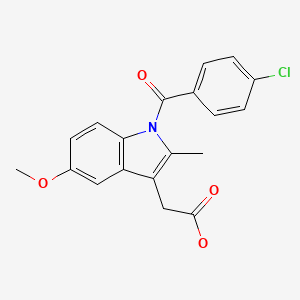Attribution Statement: LactMed is a registered trademark of the U.S. Department of Health and Human Services.
NCBI Bookshelf. A service of the National Library of Medicine, National Institutes of Health.
Drugs and Lactation Database (LactMed®) [Internet]. Bethesda (MD): National Institute of Child Health and Human Development; 2006-.
CASRN: 53-86-1

Drug Levels and Effects
Summary of Use during Lactation
Because of the low levels of indomethacin in breastmilk and therapeutic administration directly to infants, it is acceptable to use in nursing mothers. However, other agents with more published information on use during lactation may be preferable, especially while nursing a newborn or preterm infant.
Drug Levels
Maternal Levels. In one study, 15 women who were less than 1 week postpartum took indomethacin in dosages ranging from 75 mg orally to 300 mg rectally daily (0.94 to 4.29 mg/kg daily). Milk samples were taken before and after feeding at times ranging from 0.7 to 21.4 hours after the last dose. In 11 of the women, indomethacin was undetectable (<20 mcg/L) in milk. Assuming that undetectable milk levels had the concentration of the assay limit, the average dosage excreted in milk was 0.27% of maternal weight-adjusted dosage.[1] However, the excretion of the glucuronide metabolite into milk was not measured and it could be absorbed as indomethacin by a newborn.
Eight women donated milk on days 4, 12 and 26 postpartum for an in vitro measurement of protein binding and lipid partitioning of indomethacin in milk. Results were used to estimate passage into milk using physicochemical principles. The authors calculated that a breastfed infant would receive about 0.5% of the maternal weight-adjusted dosage or about 3% of the neonatal dose used to treat patent ductus arteriosus with a maternal dosage of 75 mg daily.[2] This study did not account for possible contribution to the infant's dosage by the glucuronide metabolite.
Infant Levels. In 6 of 7 infants breastfed during maternal indomethacin use of 75 mg orally to 300 mg rectally daily, the drug was undetectable (<20 mcg/L) in plasma. One infant had a plasma level of 47 mcg/L at 1.2 hours after the midpoint of the breastfeed. This infant's mother was taking 2.94 mg/kg daily of indomethacin and had a milk indomethacin level of 111 mcg/L 2.3 hours after the dose.[1]
Effects in Breastfed Infants
In one case report, a breastfeeding mother had been taking daily doses of indomethacin that increased to 200 mg (3 mg/kg) from the fourth to the sixth day postpartum. On the same day that indomethacin was stopped, the infant had a generalized seizure, followed by another on the next day. No metabolic findings could account for the convulsions and no indomethacin levels were measured in the mother or infant.[3] This case was rated as indomethacin possibly causing the seizure; however, later studies and the established therapeutic use of indomethacin in newborns make this causality seem unlikely.
In one study, 7 women breastfed their neonates while taking indomethacin. No adverse effects were noted in any of the infants.[1]
Effects on Lactation and Breastmilk
Relevant published information was not found as of the revision date.
Alternate Drugs to Consider
References
- 1.
- Lebedevs TH, Wojnar-Horton RE, Yapp P, et al. Excretion of indomethacin in breast milk. Br J Clin Pharmacol 1991;32:751-4. [PMC free article: PMC1368557] [PubMed: 1768569]
- 2.
- Beaulac-Baillargeon L, Allard G. Distribution of indomethacin in human milk and estimation of its milk to plasma ratio in vitro. Br J Clin Pharmacol 1993;36:413-6. [PMC free article: PMC1364613] [PubMed: 12959288]
- 3.
- Eeg-Olofsson O, Malmros I, Elwin CE, et al. Convulsions in a breast-fed infant after maternal indomethacin. Lancet 1978;312:215. [PubMed: 78421]
Substance Identification
Substance Name
Indomethacin
CAS Registry Number
53-86-1
Drug Class
Breast Feeding
Lactation
Milk, Human
Analgesic Agents
Anti-inflammatory Agents, Nonsteroidal
Disclaimer: Information presented in this database is not meant as a substitute for professional judgment. You should consult your healthcare provider for breastfeeding advice related to your particular situation. The U.S. government does not warrant or assume any liability or responsibility for the accuracy or completeness of the information on this Site.
- User and Medical Advice Disclaimer
- Drugs and Lactation Database (LactMed) - Record Format
- LactMed - Database Creation and Peer Review Process
- Fact Sheet. Drugs and Lactation Database (LactMed)
- Drugs and Lactation Database (LactMed) - Glossary
- LactMed Selected References
- Drugs and Lactation Database (LactMed) - About Dietary Supplements
- Breastfeeding Links
- PMCPubMed Central citations
- PubChem SubstanceRelated PubChem Substances
- PubMedLinks to PubMed
- Review Melatonin.[Drugs and Lactation Database (...]Review Melatonin.. Drugs and Lactation Database (LactMed®). 2006
- Review Marine Oils.[Drugs and Lactation Database (...]Review Marine Oils.. Drugs and Lactation Database (LactMed®). 2006
- Review Fenofibrate.[Drugs and Lactation Database (...]Review Fenofibrate.. Drugs and Lactation Database (LactMed®). 2006
- Review Primaquine.[Drugs and Lactation Database (...]Review Primaquine.. Drugs and Lactation Database (LactMed®). 2006
- Review Diclofenac.[Drugs and Lactation Database (...]Review Diclofenac.. Drugs and Lactation Database (LactMed®). 2006
- Indomethacin - Drugs and Lactation Database (LactMed®)Indomethacin - Drugs and Lactation Database (LactMed®)
Your browsing activity is empty.
Activity recording is turned off.
See more...
